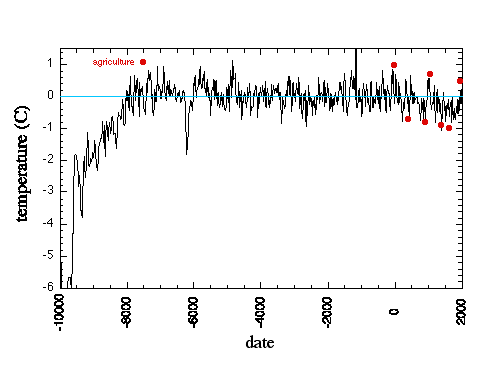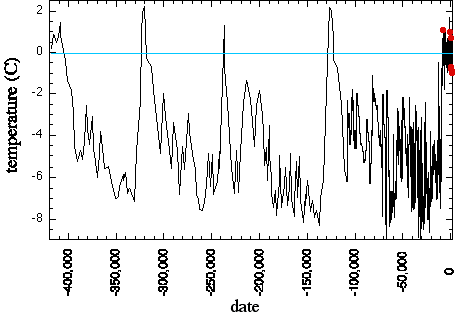 Earth 2040
Earth 2040
Posted on 04/28/2003 10:24:39 PM PDT by EdZ
This one, we're afraid, has been a long time coming: The long-expected confrontation between Mike Mann's famous "Hockey Stick" temperature history and a massive, comprehensive analysis of long-standing climate records. The head-to-head arrives in the form of a new study from Willie Soon, Sallie Baliunas and three others entitled, "Reconstructing Climatic and Environmental Changes of the past 1,000 years: A Reappraisal," published in the latest issue of the journal Energy and Environment.
The "Hockey Stick," readers will recall, is the core of the current climate hysteria...
(Excerpt) Read more at co2andclimate.org ...
Also, can anyone explain how they can say global temperatures were greater 1,000 years ago than today without giving any numerical figure (or a range of possible figures)?
I had no problem finding in the library half a dozen articles with global temperature reconstructions agreeing with the "hockey stick" graph (or at least within those big error bars), though.
 Earth 2040
Earth 2040
Probably for the same reason a couple of bicycle repairmen moonlighted in aeronautics.
The "Hockey Stick," readers will recall, is the core of the current climate hysteria, a multicentury climate history that serves as the basis for statements that the last 10 years are the hottest in the last thousand, and that there was no such thing as a global "Little Ice Age" (LIA) or the previous "Medieval Warm Period" (MWP). In other words, climate just sort of burbled along, with a slight cooling trend for 900 years, from A.D. 1000 to 1900, and then suddenly warmed to high hell. The shape of this history resembles a hockey stick (and the world is the puck) (Figure 1).

Figure 1. Mann's "hockey stick" temperature history for the past 1,000 years,
including region of uncertainty (gray area) and time periods of the
Medieval Warm Period and Little Ice Age—events that are largely absent in
this record. (adapted from the IPCC's Third Assessment Report).
Historians of science know that a new synthesis often replaces a worn-out old paradigm, especially as long-held beliefs become untenable in light of new findings. Indeed, that was the hope of the United Nations Intergovernmental Panel on Climate Change (IPCC) in its rather slavish affection for Mann's history despite many other competing analyses.
That certainly wasn't the last time the U.N. has chosen a world view with coincidentally enormous implications for the U.S. economy in the face of other logical arguments that are equally compelling. That is not to say that Mann's work is bad—in fact it is very interesting—but it is only one way of synthesizing very messy climate records and suffers from some systematic problems that Soon and colleagues have attempted to solve.
The major and most contentious problem with Mann's Hockey Stick is that it attempts to correlate 20th-century temperatures with longer "proxy" indicators—mainly tree-ring histories, problematic since it is well known that tree growth was being directly affected by increasing carbon dioxide, which makes plants more water-efficient under hot, dry conditions. Trees may have been growing better under drier 20th century conditions than they would have in the previous 900 years. As a result, the match between the two during the 20th century may bias estimates of earlier temperatures.
The Soon team simply asked different questions. Using a much larger number of "proxy" indicators than Mann did, they inquired whether there was a globally detectable 50-year period of unusual cold in the LIA and a similarly warm era in the MWP. Further, they asked if these indicators, in general, would indicate that any similar period in the 20th century was warmer than any other era.
They found that:
1) "The Little Ice Age exists as a distinguishable climatic anomaly in all regions of the world that have been assessed."
2) Only two of 50-odd proxy records showed no analogous warm time during the Medieval Warm Period.
3) "Most of the proxy records do not suggest the 20th century to be the warmest or the most extreme in its local representations."
Figure 1 is an annotated version of Mann's Hockey Stick with the "missing" LIA and MWP periods superimposed. Figure 2 (top), taken from the Soon paper, displays the distribution of proxy records (for a single location [points] or a small region [squares]) and an indication as the whether or not they show the existence of the LIA under their criteria. Figure 2 (bottom) is the same, for the MWP.
 Figure 2. Locations of climate proxies (points or regions) and whether they
Figure 2. Locations of climate proxies (points or regions) and whether they
indicate the existence of a Medieval Warm Period or Little Ice Age.
This analysis is fundamentally different from that of Mann in that it merely queries each individual record to see if there was an anomalously warm or cold period within the accepted limits of the MWP and the LIA. In many ways, it is more qualitative than Mann's work, though subject to a less ambiguous interpretation.
Certainly the most striking discovery in the Soon study is the notion that the 20th century, while warm, does not contain a 50-year anomalous period that exceeds what occurred in the MWP in many locations.
Interestingly, Soon cites many studies indicating indeed that there is a human influence on climate in the 20th century from changes in the greenhouse effect. But the observed temperature response clearly falls at the low end of projected values, something you have been reading for eight years in these pages.
What no one seems to have noticed is that the error bars in Mann's original Hockey Stick are massive—especially prior to 1600—and that they are so large that they actually could accommodate both an LIA and a MWP, which is indeed what Soon and colleagues found.
References:
Soon, W., et al., 2003. Reconstructing Climatic and Environmental Changes of the Past 1,000 years: A Reappraisal. Energy and Environment, in press.
Mann, M.E., Bradley R.S., Hughes, M.K., 1999. Northern Hemisphere temperatures during the past millennium: inferences, uncertainties, and limitations. Geophysical Research Letters, 26, 759–762.
On or off, let me know.
Also, can anyone explain how they can say global temperatures were greater 1,000 years ago than today without giving any numerical figure (or a range of possible figures)?
If you put even Mann's "Hockey stick", as as it stands, in context of the current interglacial temperature history shown by ice cores studies, you find it is a bump in the middle of nothing new at all, merely a return to nominal interglacial temperatures:
The last 4 red dots on the chart encompasses "Mann's Hockeystick" and current temperatures.
But then, the global warming sky is falling folks would have some splain'n to do if they dared to look back beyond 1 thousand years.

Last 10 thousand years since the last major Ice Age.
Like what to do when one realizes:
Mankind's impact is only 0.28% of Total Greenhouse effect
" There is no dispute at all about the fact that even if punctiliously observed, (the Kyoto Protocol) would have an imperceptible effect on future temperatures -- one-twentieth of a degree by 2050. "
Dr. S. Fred Singer, atmospheric physicist
Professor Emeritus of Environmental Sciences at the University of Virginia,
and former director of the US Weather Satellite Service;
in a Sept. 10, 2001 Letter to Editor, Wall Street Journal
And they have left out the most Major Green House gas of them all:
Anthropogenic (man-made) Contribution to the "Greenhouse
Effect," expressed as % of Total (water vapor INCLUDED)
Based on concentrations (ppb) adjusted for heat retention characteristics % of All Greenhouse Gases % Natural
% Man-made
Water vapor 95.000% 94.999%
0.001% Carbon Dioxide (CO2) 3.618% 3.502%
0.117% Methane (CH4) 0.360% 0.294%
0.066% Nitrous Oxide (N2O) 0.950% 0.903%
0.047% Misc. gases ( CFC's, etc.) 0.072% 0.025%
0.047% Total 100.00% 99.72
0.28%
And why are a couple of astrophysicists moonlighting as reviewers of paleoclimate studies?
Perhaps they were interested in the effects of precession of earths orbit in and out of the mean orbital plane of the solar system.
Origin of the 100 kyr Glacial Cycle
by Richard A. Muller

Climate for the last 420 kyr, from Vostok ice
Introduction
For over a century it has been argued that changes in the Earth's orbital eccentricity were responsible for the primary cycle of the ice ages (ref 1-4). Although the eccentricity changes were small (between 0.01 and 0.05), they can be calculated with good accuracy back at least several million years (ref 5, 6) and they show quasi-periodic behavior with a period of about 100 kyr. Milankovitch (ref 2) proposed that the eccentricity affected the climate through its effect on insolation, the average solar energy reaching the earth. The discovery (ref 3) of a strong quasi-periodic 100 kyr cycle in the climate data, in approximate phase coherence with the eccentricity, gave strong support to the theory. But the calculated insolation changes from eccentricity were too small to account for the strong 100 kyr cycle (ref 7). Moreover a second expected eccentricity period near 400 kyr is absent in most climate records, leading to specific disagreements between eccentricity and glacial data at both 400 ka and the present. Dozens of proposed explanations for the discrepancies have been proposed; in a recent review, Imbrie et al. (ref 8) give a "short list" consisting of seven different groups of models. Many involve resonant or nonlinear behavior of the ice-ocean-atmosphere system; some derive the 100 kyr period from the envelope of the variation in the precession parameter.
As dating has become more accurate, another possible problem with the Milankovitch insolation mechanism has developed: several recent experiments suggested that the abrupt terminations of the ice ages preceded the warming from insolation (ref 9, 10), an effect we refer to as the "causality problem." The interpretation of these results has been debated (ref 11, 12, 13). Imbrie et al. (ref 11) argued that a true test of the Milankovitch theory must be performed in the frequency domain, not the time domain. However we will show that the Milankovitch theory also has a previously unrecognized and serious problem in the frequency domain.
In this paper, we present a new full-resolution spectral analysis of delta18O proxy climate records. The analysis exposes spectral features that have a direct bearing on the validity of published models. In particular, the 100 kyr period is shown to yield a narrow single peak, a simple pattern that strongly confirms an astronomical origin, but which cannot be reconciled with any of the models presented in the review by Imbrie et al. (ref 8)
We will also show that a previously ignored astronomical cycle, that of the orbital inclination, passes the spectral tests failed by the eccentricity. In addition the cycles precede the effects, and thus have no causality problem. Although the orbital inclination does not affect the insolation and therefore was ignored by previous analysts, the match to the spectrum and bispectrum is excellent, and so a linking mechanism to climate should be sought. We will speculate on one possibility for that mechanism: the accretion of extraterrestrial dust or meteoroids.
True, the problem would be Greenland and Antarctica.
If the end of the current inter-glacial period happens this century, all that worrying about California's 'Big One' will seem laughable.
Except the weight of the glaciers on LA & San Fran will break a chunk off California and dump them into the ocean.
Better, get the worry beads out again. :O}evil grin
my call sign green team is not related to the environment or tree huggers.
i`m just joking about the end of the world the environmentalist people live,love and wait for.
Disclaimer: Opinions posted on Free Republic are those of the individual posters and do not necessarily represent the opinion of Free Republic or its management. All materials posted herein are protected by copyright law and the exemption for fair use of copyrighted works.